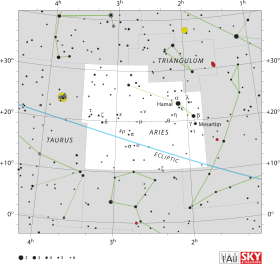Caractéristiques physiques
Masse
2,10+0,37 [ 7] M ☉ [ 8] +0,02 M ☉ [ 7]
Rayon
1,9 à 2,5 R ☉ [ 9]
Gravité de surface (log g)
4,00 ± 0,25[ 7]
Luminosité
106 L ☉ [ 6]
Température
9 500 ± 1 000 K [ 7] K [ 7]
Métallicité
? / 0,0[ 7]
Rotation
186 km/s[ 10] [ 7]
Âge
107+286 Ma [ 7]
Désignations
modifier
Theta Arietis ou θ Arietis est une étoile binaire [ 7] constellation du Bélier . Elle est faiblement visible à l'œil nu avec une magnitude apparente de 5,58[ 2] parallaxe de 7,61 mas [ 1] a.l. pc Système solaire avec une vitesse radiale de +6 km/s [ 2]
Le composant A est une étoile blanche de la séquence principale avec un type spectral A1Vn[ 3] vitesse de rotation de 186 km/s [ 10] nébulaire » des raies d'absorption indiquées dans le suffixe « n » dans son type spectral. En 2005 , C. Neiner et al. étoile Be car elle présente des caractéristiques d'émission dans les séries de Balmer [ 5]
En 2016 , un composant B a été détecté en orbite proche autour du composant A, sur la base d'observations utilisant l'optique adaptative avec l'observatoire Gemini [ 7]
↑ a b c d e et f
(en) A. G. A. Brown et al. Gaia collaboration), « Gaia Data Release 2 : Summary of the contents and survey propertiesAstronomy & Astrophysics vol. 616, août 2018 , article no A1 (DOI 10.1051/0004-6361/201833051 Bibcode 2018A&A...616A...1G arXiv 1804.09365
↑ a b c et d (en) R. Wielen et al. Sixth Catalogue of Fundamental Stars (FK6). Part I. Basic fundamental stars with direct solutions Veroeffentlichungen des Astronomischen Rechen-Instituts Heidelberg vol. 35, no 35, 1999 (Bibcode 1999VeARI..35....1W ↑ a et b (en) A. Cowley et al. A study of the bright A stars. I. A catalogue of spectral classifications The Astronomical Journal vol. 74, avril 1969 , p. 375–406 (DOI 10.1086/110819 Bibcode 1969AJ.....74..375C ↑ a et b (en) E. Rybka, « The corrected magnitudes and colours of 278 stars near S.A. 1-139 in the UBV system Acta Astronomica vol. 19, 1969 , p. 229 (Bibcode 1969AcA....19..229R ↑ a et b (en) C. Neiner et al. The Identification of New Be Stars in GAUDI The Astronomical Journal Supplement Series vol. 156, no 2, février 2005 , p. 237–243 (DOI 10.1086/426670 Bibcode 2005ApJS..156..237N S2CID 123143757 ↑ a et b (en) E. Anderson et Ch. Francis, « XHIP: An extended hipparcos compilation Astronomy Letters vol. 38, no 5, 2012 , p. 331 (DOI 10.1134/S1063773712050015 Bibcode 2012AstL...38..331A arXiv 1108.4971 S2CID 119257644 ↑ a b c d e f g h i et j (en) Kevin Gullikson et al. The Close Companion Mass-ratio Distribution of Intermediate-mass Stars The Astronomical Journal vol. 152, no 2, août 2016 , p. 13 (DOI 10.3847/0004-6256/152/2/40 Bibcode 2016AJ....152...40G arXiv 1604.06456 S2CID 119179065 ↑ (en) J. Zorec et F. Royer, « Rotational velocities of A-type stars. IV. Evolution of rotational velocities Astronomy & Astrophysics vol. 537, 2012 , article no A120 (DOI 10.1051/0004-6361/201117691 Bibcode 2012A&A...537A.120Z arXiv 1201.2052 S2CID 55586789 ↑ (en) L. E. Pasinetti Fracassini et al. Catalogue of Apparent Diameters and Absolute Radii of Stars (CADARS) - Third edition - Comments and statistics Astronomy & Astrophysics vol. 367, no 2, février 2001 , p. 521–524 (DOI 10.1051/0004-6361:20000451 Bibcode 2001A&A...367..521P arXiv astro-ph/0012289 S2CID 425754 ↑ a et b (en) F. Royer, J. Zorec et A. E. Gómez, « Rotational velocities of A-type stars. III. Velocity distributions Astronomy & Astrophysics vol. 463, no 2, février 2007 , p. 671–682 (DOI 10.1051/0004-6361:20065224 Bibcode 2007A&A...463..671R arXiv astro-ph/0610785 S2CID 18475298 ↑ (en) tet Ari sur la base de données Simbad Centre de données astronomiques de Strasbourg .
Liens externes
Ressource relative à l'astronomie :
